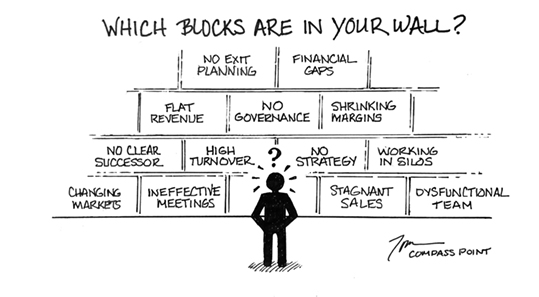TRANSITION / SUCCESSION
How to FAIL at succession planning in 3 easy steps…

While I love reading articles like “the top 10 ways to….” or “how to succeed in business without really trying”, sometimes I’m more curious about how to avoid mistakes or pitfalls. This leads me to today’s topic: how to fail at family business succession planning.
First, what is a succession plan? Before I tell you how to avoid failing at it, it’s best that I define it first. Succession planning can mean many things in business – but here’s a quick definition:
A succession plan is…
• Defining WHO will be running the company after the current owner and identifying people for the key functional areas of the company
• Establishing WHAT the financial plan is for the transfer of ownership
• Establishing HOW the successor and other key talent in the business will be nurtured for their future leadership roles.
First Failure Step: Head-in-the-Sand Tactic
So, let’s talk about the first way to fail at succession planning, purely based on that bulleted list. I would call this the “head in the sand” tactic. Also known as the “it will never happen to me” strategy.
We fail at succession planning when we as business owners and leaders think that we don’t need to train anyone to do our job because we’ll be there until our last day on earth and the rest of the company will be fine when we are gone.
Second Failure Step: ASSUME
That old adage of “assuming makes an a** out of you and me exists for a reason. Owners make the assumption that those around us know what we know, purely by osmosis. That tribal knowledge that is locked inside your owner’s head has to be written and communicated to the next generation (family or not) so that it is not only heard, but also understood. Succession planning at its core is quite simply documentation and communication of that documentation.
In terms of the second bullet – WHAT the financial plan looks like – you’ll have to wait until next month when I talk about personal financial gaps and why they are important for the transfer of ownership. But what I will say about this now is that to fail at this is not bringing your team of advisors (attorneys, accountants, business coaches and consultants, and wealth managers) together so everyone has a clear picture to best support the successful transition.
Third Failure Step: THERE WILL BE TIME
Having the mindset that there will be time tomorrow, next year or whenever you make the decision to exit is the third way to fail at succession planning. Documentation takes TIME. And time is something very sacred and hard to come by, especially for business owners. Just take a moment to download our ebook “the 5Ds of Life” to get acquainted with life events that can derail not only your life, but the business as well.
If business owners don’t take the time to document their roles, responsibilities, and other key facts, and then also communicate those pieces of information to successors, those successors are much more likely to fail.
NOW… 3 Steps to Succeed at Succession Planning!
I could not let this blog be only about the missteps and failures that are all too prevalent in succession planning. As a family business advisor, it is my nature to share the tips and tools to keep the business going and growing.
First Success Step: Head Up & Mind Open
While there are a lot of lessons to be learned from one who builds a successful business, the way a business is built from the ground up is VERY different from growing a business from $1M to $5M or from $5M to $20M. Recognize that your successor will have different challenges – and ideas on how to address them – than you did as the previous generation. Keep an open mind.
Second Success Step: Plan for the Unexpected
In contrast to making assumptions around knowledge, bring your team of advisors together so everyone has a clear picture to best support the successful transition. This team may include some or all of the following: attorneys, accountants, business coaches/consultants, and wealth managers. Whether it’s your life event, that of a loved one or an external event (like a global pandemic), your transition plan needs time to develop and a team to support it.
Third Success Step: It’s more than just YOU.
Succession planning is for more than the business owner or president. Succession is crucial for other key roles in the business as well. For instance, let’s look at your CFO. They have been with the company for nearly 20 years and hold the proverbial financial keys to your kingdom. With no one being mentored under them, what happens if the CFO doesn’t show up for work tomorrow or for the next month? What if they leave abruptly? When planning for succession, being successful means planning to replace all key roles in the business – not just you..
Want to know how to succeed at succession planning? Schedule a 60-minute coaching call to avoid the mistakes above and plan for your future!
You may also like…

BLOG | EXECUTION
Hitting a Wall in Business: Which Blocks are in Your Wall?
A management team had hit “that wall”. Sales were stagnant and communication was at an all-time low. The team dreaded meetings and they weren’t sure how to move forward. Learn how the owner transformed his stagnant company with the help of a new CFO and consulting support, resulting in a significant profit increase and revitalized team dynamics.
Read More
BLOG | CUSTOMER
How Family Businesses Can Navigate Post-COVID Challenges
“In quiet and untroubled times, it seems to every administrator that it is only by his efforts that the whole population under his rule is kept going..."
Read More
BLOG | FAMILY DYNAMICS / GOVERNANCE
Becoming a Family Business: This Firm Lives What They Teach
You may know the man in the photo as Tom Garrity, Founder of Compass Point, a family business consulting firm in Southeastern PA, headquartered in the Lehigh Valley; I know him as my inspiration, mentor, confidante, tennis partner, and best of all – my dad. This blog marks...
Read MoreWhere Family Businesses Come to Grow & Learn
At Compass Point, we make it easy to get insights, training, tools, and articles straight to your inbox and help family business owners and their team continue to grow, learn, and lead.


